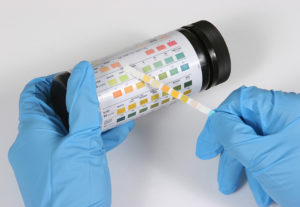Urinalysis
Physicians have been using urinalysis, or urine testing, as a diagnostic tool for about 6,000 years. Nowadays, with updated and improved methods, it remains an effective, quick, and easy way to find out more about your overall health. In fact, you may have already had one at an annual physical or other medical appointment.
In our office, we use urinalysis to diagnose urologic conditions, like kidney stones and urinary tract infections. We also use urine tests to monitor your progress if you’ve already been diagnosed.
What do we look for?
A urinalysis has 3 main parts: a visual test, a microscope test, and a dipstick test
In general, a urinalysis has 3 main parts:

A visual test
The color of your urine can tell us a lot. Normal urine is usually clear or pale yellow. But if it has a red, pink, or brown tint to it, that could signify blood in your urine (hematuria). If it’s cloudy, you might have an infection. If it’s foamy, that could be a sign of kidney disease.
A microscope test
We use a microscope to look for what isn’t so obvious. For example, blood can be present in your urine even if it looks normal. This is called microhematuria. The blood cells are so small, you can’t see them with the naked eye. They can be detected only with a microscope.
In addition, a microscope test can show bacteria and white blood cells – two signs of infection. It might also show us crystals in your urine that could eventually develop into kidney stones.

A dipstick test
This test tells us whether certain chemicals or other substances, such as proteins and sugars, are in your urine. It measures your urine’s acidity (pH). A higher pH might indicate kidney stones, urinary tract infections, or other urological conditions. It also measures the concentration (also called the specific gravity) of your urine, which tells us how hydrated you are.
The dipstick itself is a strip of specially-treated plastic that we place in your urine sample. If certain chemicals are present or fall within abnormal ranges, areas of the dipstick will change color.
Sometimes, a dipstick test is done with tablets placed in the urine sample. But the general idea is the same; the tablets can detect certain chemicals in the urine.
Taken together, all of these analyses give clues that help us diagnose your urological problem. We’ll also conduct a physical exam and consider your health history, family medical history, medications, and lifestyle habits to get a complete picture.
We use urinalysis to diagnose urologic conditions, like kidney stones and urinary tract infections
How do I prepare for a urine test?
We can do a urinalysis here at the office. Or you might prepare your urine sample at home and bring it to us. We’ll give you specific instructions ahead of time. For example, we might ask for a fasting urine sample taken first thing in the morning. If that’s the case, then you’ll collect your urine before eating anything that day.
We might also advise you not to take certain medications or supplements beforehand, as these can affect the results. Similarly, some foods and beverages can make urine change color. We’ll let you know the specifics for your urine test. And as always, if you have any questions, please give us a call.
What is a “clean-catch” sample?
Giving a urine sample is fairly simple, but it’s important for it to be a clean-catch sample. When you urinate, germs from your genital area can mix in with urine. The clean-catch method eliminates this mixing as much as possible.
For this test, we’ll give you a clean catch kit. Your kit will contain sterile wipes, a sterile cup, and a label with your name on it.
- Start by washing your hands thoroughly with soap and water. Take the lid off the cup.
- Use the sterile wipes to clean your genitals before you urinate. Women will wipe the inner folds of their labia and the area around their urethra. Men will clean the tip of their penis. (Uncircumcised men should retract their foreskin first.)
- Next, start urinating into the toilet bowl. Then stop for a moment. In other words, hold the flow of urine.
- Carefully position the cup so that urine can flow into it.
- When the cup is about halfway full, stop the flow again. Put the cup aside and finish urinating into the toilet bowl.
- Put the lid securely on the cup without touching the inside. Be sure not to touch the urine either.
- We’ll let you know where to place your sample. If you collect your sample at home, it should be refrigerated unless we tell you otherwise.
Once your sample is analyzed by the lab, we’ll contact you and go over the results and next steps.
Urinalysis doesn’t always give a complete picture of your health, but it will tell us what needs watching and follow-up. Remember, we are always here to answer your questions.
Resources
European Association of Urology
“Urine Test”
(Last updated: February 2021)
https://patients.uroweb.org/tests/urine-test/
HealthCommunities.com
“Urinalysis”
(Page last modified: July 23, 2015)
[Accessed via www.archive.org]
Mayo Clinic
“Urinalysis”
(October 23, 2019)
https://www.mayoclinic.org/tests-procedures/urinalysis/about/pac-20384907
MedlinePlus
“Clean catch urine sample”
(Page last updated: January 5, 2021)
https://medlineplus.gov/ency/article/007487.htm
“Urinalysis”
(Page last updated: June 9, 2020)
https://medlineplus.gov/urinalysis.html
National Kidney Foundation
“What is a Urinalysis (also called a "urine test")?”
https://www.kidney.org/atoz/content/what-urinalysis
StatPearls [Internet] via PubMed.gov
Milani, Daniel A. Queremel and Ishwarlal Jialal
“Urinalysis”
(Last update: May 9, 2021)
https://pubmed.ncbi.nlm.nih.gov/32491617/
Urology Care Foundation
“What is a Urinalysis?”
https://urologyhealth.org/urology-a-z/u/urinalysis
WebMD
“The Truth About Urine”
(Reviewed: February 15, 2020)
https://www.webmd.com/urinary-incontinence-oab/truth-about-urine
